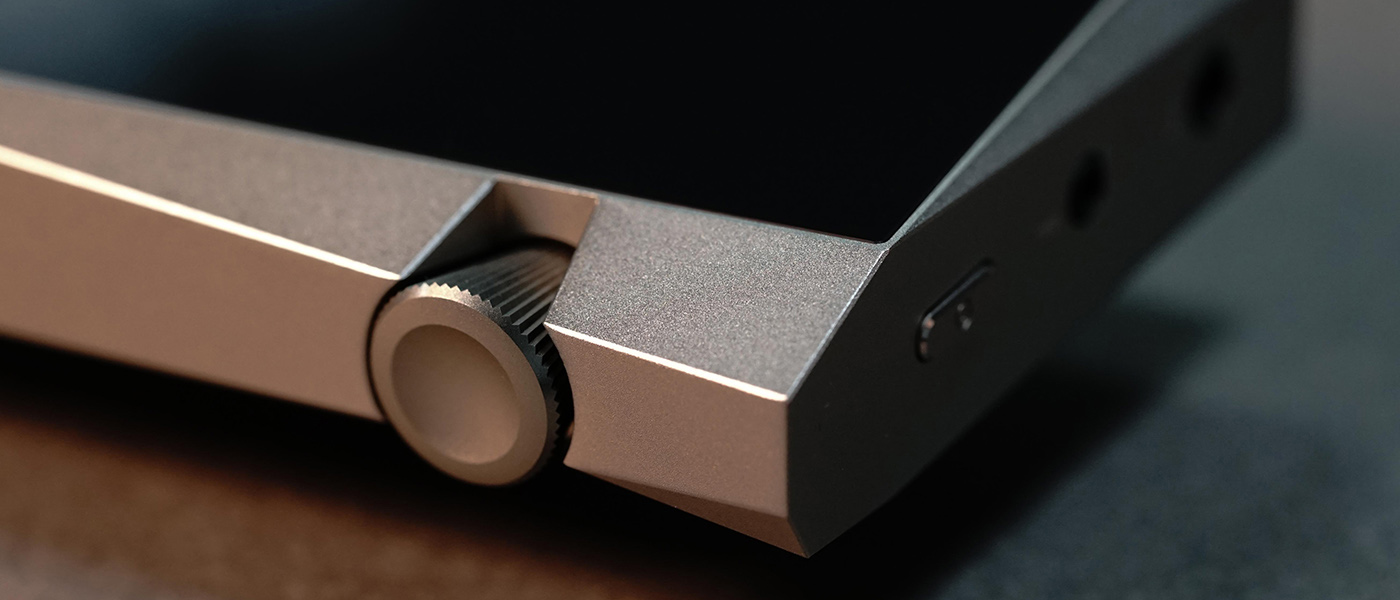
Astell&Kern KANN CUBE and Billie Jean IEM
- Powerful dual ESS ES9038PRO DAC chip construction
- Has both Balanced and Unbalanced headphone jacks with potent amp section
- XLR line out (custom cable required) for a balanced connection to home audio gear
- Up to 32bit/384kHz PCM playback, Native DSD256 support, and MQA
- Unique design and accessible user interface
- High storage capacity and room for streaming plugins
I must have gone through more earbuds than I have fingers since I first picked up the habit. Whether it’s walking through the halls of my high school, walking my family’s dogs, or simply lying in bed without sleep, I almost always have some song or another pumping into my eardrums.
That being said, I am still somewhat of a pleb when it comes to on-the-go high fidelity listening. I usually just default to my phone and any pair of functional earbuds I can find for convenience’s sake. Sure, I have a handful of FLAC files loaded on my phone, but the true audiophile may loathe seeing my regular pocket listening rig. I don’t know who told Astell&Kern my deep, dark secret, but apparently, they saw fit to supply me with an upgrade. Or, more accurately put, a transformative experience. And so the KANN CUBE and the Billie Jean in-ears appeared at my doorstep.
KANN CUBE
Construction:
Aluminum body
Display Size:
5” touch display (720 x 1280)
Supported File Formats:
WAV, FLAC, WMA, MP3, OGG, APE, AAC, ALAC, AIFF, DFF, DSF, MQA
MQA Playback:
Services (Tidal Masters), Local files, External USB, MQA-CD (ripped)
DAC Chipset:
Dual ESS ES9038PRO (One per Channel)
Sample Rates:
Up to 32-bit/384 kHz PCM and up to DSD256 native playback
Output Level (Phones):
High: Unbalanced 6Vrms / Balanced 12Vrms (Condition No Load)
Mid: Unbalanced 4Vrms / Balanced 8Vrms (Condition No Load)
Low: Unbalanced 2Vrms / Balanced 4Vrms (Condition No Load)
Output Level (Line out):
XLR 4Vrms (Condition No Load)
Frequency Response:
20 Hz – 20 kHz +/- 0.027 dB (Unbalanced Phones)
20 Hz – 20 kHz +/- 0.025 dB (Balanced Phones)
10 Hz – 70 kHz +/- 0.07 dB (Unbalanced Phones)
10 Hz – 70 kHz +/- 0.087 dB (Balanced Phones)
SNR:
117 dB @ 1 kHz (Balanced and Unbalanced Phones)
128 dB @ 1 kHz (XLR Line out)
THD + N:
0.0004% @ 1kHz (Unbalanced Phones)
0.0005% @ 1kHz (Balanced Phones)
0.0004% @ 1kHz (XLR Line out)
Input:
USB Type-C input (for PC & MAC)
Outputs:
Unbalanced Out (3.5mm) / Optical Out (3.5mm) / Balanced Out (2.5mm, only 4-pole supported) / XLR Out (Mini 5pin)
Wi-Fi:
802.11 b/g/n (2.4GHz)
Bluetooth:
V4.2 (A2DP, AVRCP, aptX HD)
Battery Capacity:
7,400mAh 3.8V Li-Polymer Battery
Playback Time (Manufacturer): 9 Hours (Standard Listening, Low Gain, Screen off)
Charge Time:
Approx 4 hours (Standard – 9V/1.67A Fast charging)
Approx 5.5 hours (Standard – 5V/2A General charging)
Built-In memory:
128 GB
External Memory:
Up to 1 TB via single microSD card
Supported OS:
Windows 7,8,10 (32/64bit), MAC OS X 10.7 and up
Dimensions:
3.45” W x 5.51” H x 1.24” D
Weight:
17.3 oz
Color:
Wolf Grey
MSRP:
$1499.00
BILLIE JEAN EARBUDS
Model:
Billie Jean
Type:
Universal fit IEM
Driver Unit:
2-way, 2 Balanced Armature Drivers (High, Full Range (mid & low) per side
Impedance:
18-ohm
Noise Isolation:
-26db
Components:
3.5 mm Unbalanced Cable, 3 sizes of silicone ear tips, carrying case (Purple model also comes with a 2.5 mm Balanced Cable)
Colors:
Red, Blue, Purple
MSRP:
$349.00
Company:
TAGS:
astell&kern, kann, CUBE, dap, iem, balanced, Audio Player Review 2019
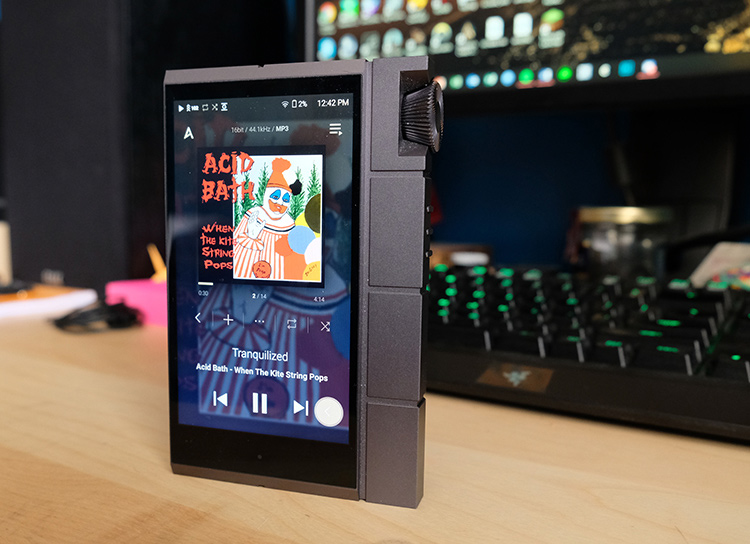
I was excited to hear that I would have the chance to live the life of an audio bourgeoisie, with both a high-quality portable audio player and a pair of upmarket in-ears. What I wasn’t expecting was the monolith from 2001 A Space Odyssey to arrive in the mail. The name “CUBE” is not ill-fitting; it boasts both sharp, defined corners and an intimidating weight. I suspect that if the owner of a CUBE was placed in a fight-or-flight situation, the product would serve as an effective last-ditch defense measure (that is if you don’t mind getting blood on your $1500.00 audio player).

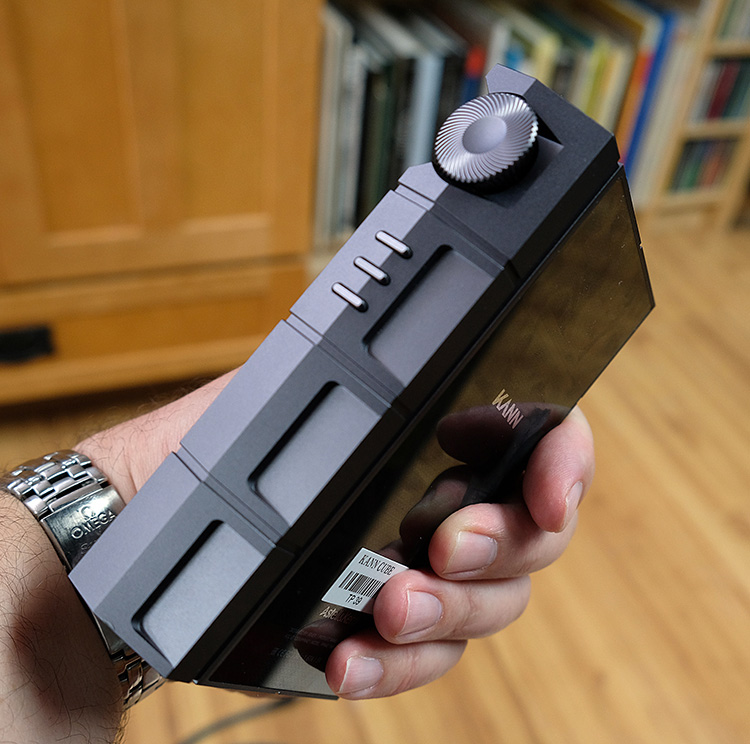
This is not meant to diminish the design of the CUBE, however. Despite its potential to cause brain trauma, the CUBE is a joy to behold. As someone who wears almost exclusively black t-shirts, the CUBE fits in perfectly with my wardrobe and manages to combine harsh angles with smooth, tranquil faces. The buttons are crisp, and the volume knob turns with satisfying cadence and a gentle clicking, situated just above three buttons (previous, play, next) on the side. The user interface falls in parallel with the exterior design, using a stripped-down Android framework to propel the sleek and smooth experience. It is obviously constructed with ease of use in mind, as the whole of the device’s capabilities are a swipe away at any time. The player accepts all forms of audio file that I’ve loaded on it and is as simple as drag-and-drop from your preferred computer experience. The KANN CUBE will digest rail-thin MP3 files all the way up to bodybuilder 32/384 PCM and DSD256 files, along with the more elusive file types such as MQA. This isn’t your dad’s iPod.
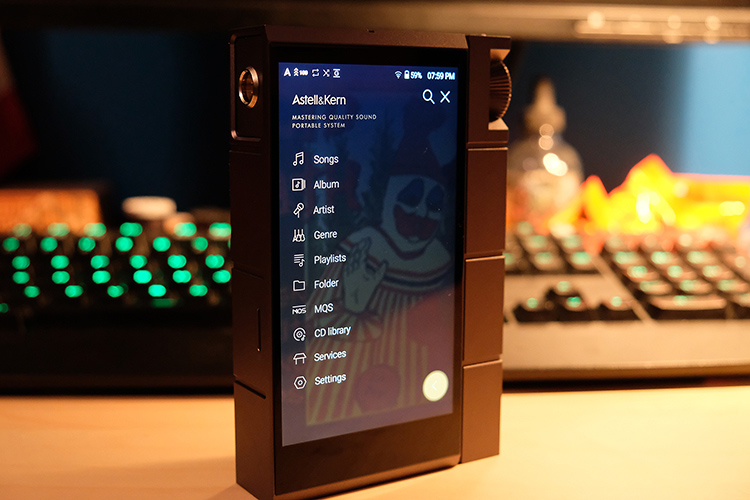
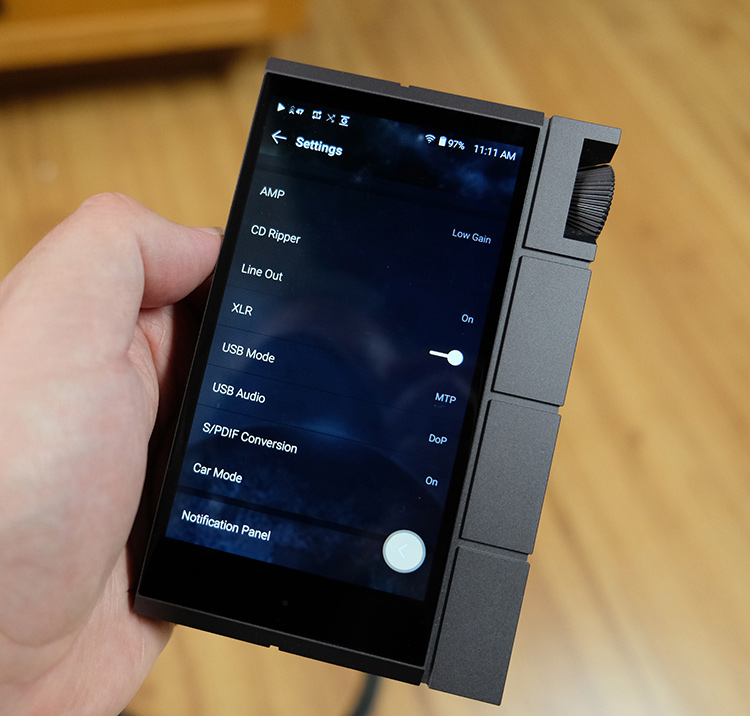
At the heart of the KANN CUBE are the twin ESS ES9038PRO DAC chips. Make no mistake, Astell&Kern didn’t shortchange the CUBE by watering these chips down and including the usual portable listening rig fare. These two chips wield eight channels each; they’re the same sort of chips that appear in high-end home and pro audio equipment. One entire 8-channel chip is devoted per channel for superior dynamic range and ultra-low THD. This, in turn, offers a partial explanation for the CUBE’s herculean 7,400mAh 3.8V Li-Polymer Battery. That’s right, this battery is twice the size of the one that Astell&Kern outfitted its flagship SP2000 with, even though both players are rated for roughly the same amount of playing time. Such a big battery is a necessity for the CUBE because the two DAC chips are thirsty and the updated head amp section is equally brawny. While on the subject of power, I found myself looking in vain for a charger once I got the unit itself out of the box. The unit came with a cable for loading music, but no adapter. I know that in this increasingly wired world, most people will have one adapter or another that will suit the CUBE’s needs, but considering that one needs to furnish $1500 to have a CUBE of their own, the absence of a charger feels like an oversight. Using a 9V-1.67A charger will fully feed the CUBE in roughly 4 hours. A more common 5V-2A charger will do it in about 5 and a half.

The headphone amp that the CUBE is armed with has been beefed up over the previous generation unit, providing anywhere from 2V unbalanced/4V balanced output at Low Gain up to 6V unbalanced/12V balanced output at High Gain. Connections are made via the 3.5mm standard headphone jack or 2.5mm balanced headphone jack. One would be hard-pressed to find a pair of headphones that the CUBE won’t be able to power. There are also some fairly sophisticated EQ resources at the unit’s disposal, should you need to more finely hone some unruly peripherals.
The KANN CUBE can import, edit or create playlists just as easily as a phone, and it can be outfitted to stream over wireless with services such as Spotify or Tidal, needing only the appropriate Open App service on the player, all of which are easy enough to install. It also uses wireless capability to update its firmware, which streamlines functionality further.
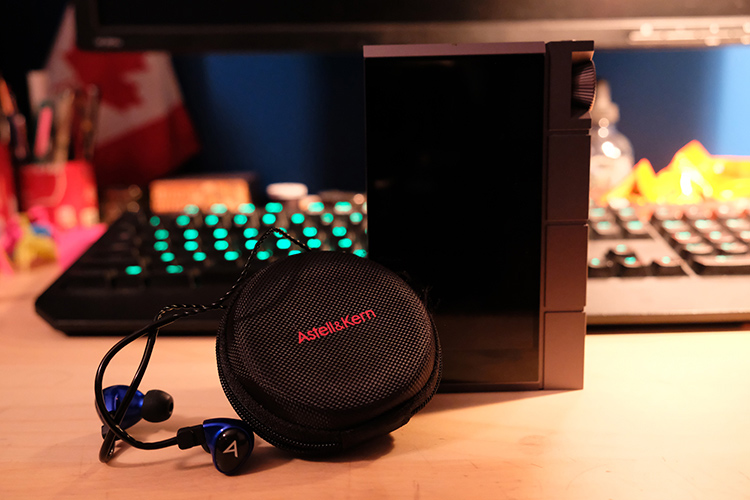

The Billie Jean earbuds that came at the CUBE’s side are equal in prestige. Produced in conjunction with noted IEM designer Jerry Harvey, the Billie Jeans feature dual balanced armature drivers, an over-the-ear design (although I personally prefer the classic bullet-style earbud), 18-ohm impedance and -26db noise isolation. The earbuds, despite wrapping all the way around my ears, fit in nicely and stayed put, filtering out unwanted noise both in controlled use with the CUBE and during bike rides. Furthermore, the Billie Jeans command a “unique Acoustic Chamber Sound Bore” design that is touted by Astell&Kern to provide “a wider soundstage with incomparable dynamic range” to the sound. The cable used in the Billie Jeans is made from silver-plated copper wire that has been flattened and then wrapped around multiple strands of Kevlar filament. Astell&Kern claims that this results in a headphone cable with excellent sound quality and superior durability. The earbuds, when tested with my usual plebian listening habits, perform considerably better than my daily driver earbuds, managing to meld the output from my phone into a more enjoyable experience with a fuller and more poignant sound. The Billie Jeans have a lot packed into them, both justifying the $350 price tag and providing the user with a more enjoyable experience.
At first, I tested the CUBE with my daily driver earbuds and then the Billie Jeans that arrived at the CUBE’s side. The CUBE delivers a high-quality experience with both, presenting an aptitude for clear delivery and a full-bodied sound. While my usual earbuds perform well with the CUBE, the Billie Jeans synergize with it and deliver an experience that hits all the right notes, both literally and figuratively. The pairing of the CUBE and the Billie Jeans was no accident on A&K’s part. The powerful experience is no doubt a product of the CUBE’s twin ESS PRO DAC chips, wielded in a complex jab-cross that ensures well-rounded audio delivery. The CUBE does not deviate from this precedent with the balanced jack, either. It was with this that I used two of the beefiest pairs of headphones in my household, the HifiMAN HE1000 v2 and the Beyerdynamic DT-880 (250 ohms). Needless to say, the experience was taken a few steps forward with this setup, and then… I almost forgot that I had headphones on. It’s a tricky thing to get the listener immersed in the sound, but the CUBE will go as deep as you let it. The DT 880 are a particularly thirsty set of cans that need a good amount of power to make them sound their best. Setting the KANN CUBE’s amp section to High made the Beyers sing ever so sweetly at just over half volume.
Secrets Sponsor
It’s here that I have to cease the colorful metaphor and note the tradeoff that one makes with the CUBE. The fact that the CUBE is armed to the teeth with heavier duty components means that the CUBE suffers in the department of battery life. The company claims 9 hours of battery life with “standard usage.” This means playing the unit with standard resolution files, the amp gain set Low and the screen off. As my regular listening pattern couldn’t always be considered “standard”, I was confined to around 6 hours of listening at most before I was forced to plug the CUBE in and allow it to refuel. This ravenous thirst means that the product starts to lack convenience. Throughout a day of carrying this around and listening to music during a day of work or on a flight, one would have to charge it fairly regularly. This is not the only aspect that the CUBE’s might detracts from, as the beefy components mean that the device is a massive departure in size from the average phone, making it somewhat annoying to carry around in a pocket as I tend to do. Everything is dual and everything has poles, the CUBE sacrifices compact design for a superior experience, which is a sacrifice some are willing to make.
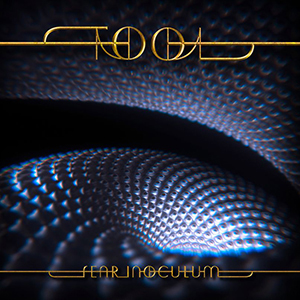
Listening to this album on the CUBE was mandatory. There is no other way to say it. This album has been awaited, patiently, for thirteen years by leagues and leagues of fans. There were plenty who denied it would ever happen, but we now live in a time where you can hold the new Tool album in your hand.
The album itself was worth the wait, but the CUBE brings the experience of sitting down with this album on the go. Boasting seven songs that are each ten to fifteen minutes long, this album isn’t intended to fill the same niche as pop songs that provide simple background music to everyday activities. Listening to the CD copy of Fear Inoculum is an experience that treads the line into the religious, but streaming the album leaves something to be desired. Tool has always wanted the listener to take their time with their albums. They’re notorious for their virtuosic musicianship, which isn’t something to be taken lightly. The clarity of Justin Chancellor’s bass tone, the depth of Adam Jones’ guitar riffs, Maynard James Keenan’s melodic vocals and Danny Carey’s effortlessly complex percussion backing are all recited with clarity and proper justice by the CUBE. Whiling away a long car ride while still digesting the full depth of Fear Inoculum into my ears is something I wouldn’t be able to do without the CUBE.
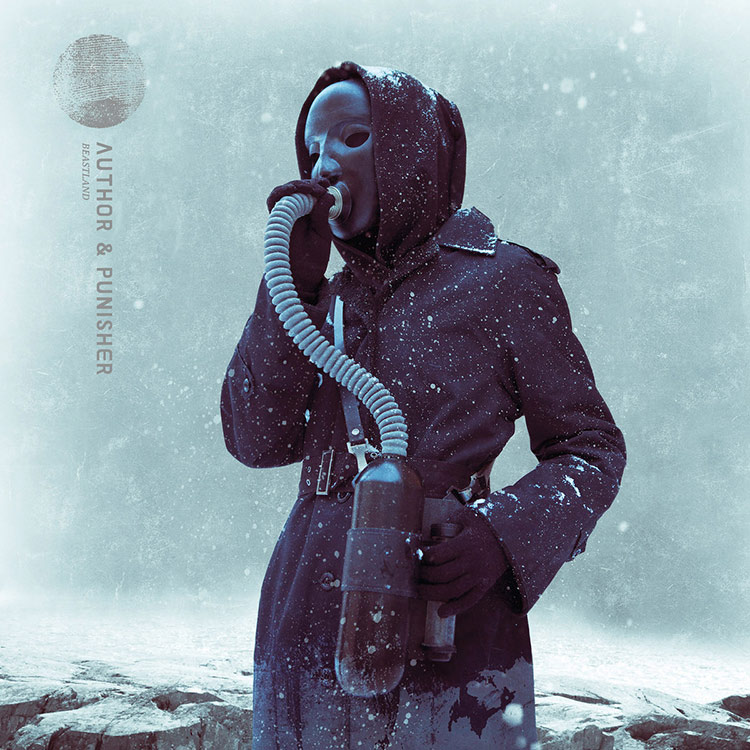
Immediately after the eerie sounds of “Pharmacide” spool up from within the CUBE, some strange synergy begins to make itself known. The CUBE, oddly enough, begins to look (and sound) like a piece of Tristan Shone’s mad-science industrial-pipe-organ-slash-prosthetic-instrument.
For those who don’t know, Shone’s “Gridiron rig” that he uses to create his acoustic soundscapes is a feat of engineering. A piece of machinery that the man designed himself, hewn from solid aluminum, which he uses to blur the line between organic musicianship and cold, abrasive, mechanical sound. The CUBE plays this album as if it’s telling an anecdote, something it experienced in a past life, rather than reciting an mp3 file. It’s an odd sensation, but one that spelled a very unique experience. There’s a marked improvement over my usual listening mode with the CUBE; deeper, nastier lows and whining highs, mounted by vocals that tear through the cold. Harrowing, yes, but also deeply enjoyable.

Canadian death metal outfit Auroch does little to hide their esoteric roots, steeping their chaotic musicianship in strange, Kabbalistic double-meanings and drawing from works penned by candlelight eons ago. The CUBE, however, is unfazed by the monumental complexity of the trio’s work, instead, taking it in its stride and delivering the searing, furious guitar riffs and blast-beats like the monolith it resembles, creating an experience that seems like it belongs in the mind of H.P. Lovecraft.
The stars are right, and the CUBE knows it. Being one of the albums that I tested in lossless form, the CUBE delivers the full depth and scope of Sebastian Montesi’s demented visions with a fidelity that seems to rise from a city hidden behind those menacing, dark Mountains of Madness. Deep, guttural vocals hurl forth from behind the display, delivered with grit and precision. Chaotic drums signal a distant march carried out by creatures that walk on more legs than can be conceived of, rendered deep and full by the player. The guitars are screaming and writhing like something not of this earth, but something earthly is playing them for me.
Bench tests and analysis by Carlo Lo Raso and David A Rich.
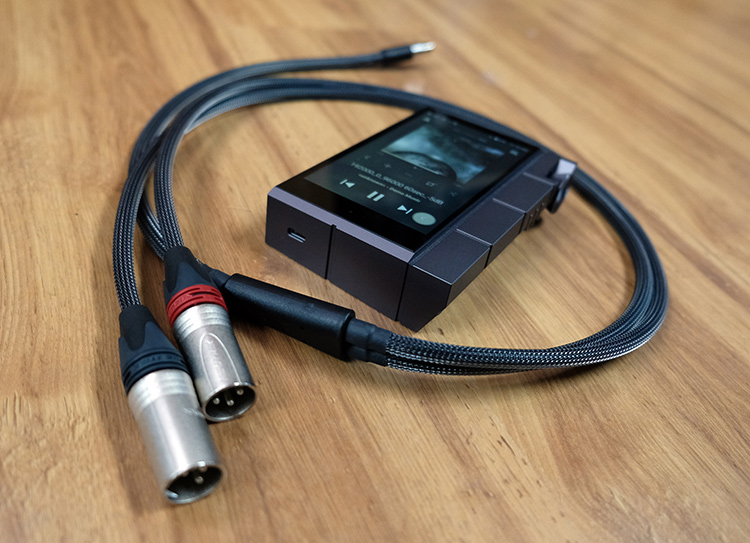
Benchmark audio tests were conducted on the DAC section of the Astell&Kern KANN CUBE. Various custom digital test tones were loaded into the DAP’s storage memory and played through the optional balanced line output interconnect cables. The results were measured with SpectraPLUS audio measurement software via a LYNX TWO B professional sound card. Measurements taken with the balanced XLR outputs were measured at a 4 Volts RMS reference level unless otherwise stated.
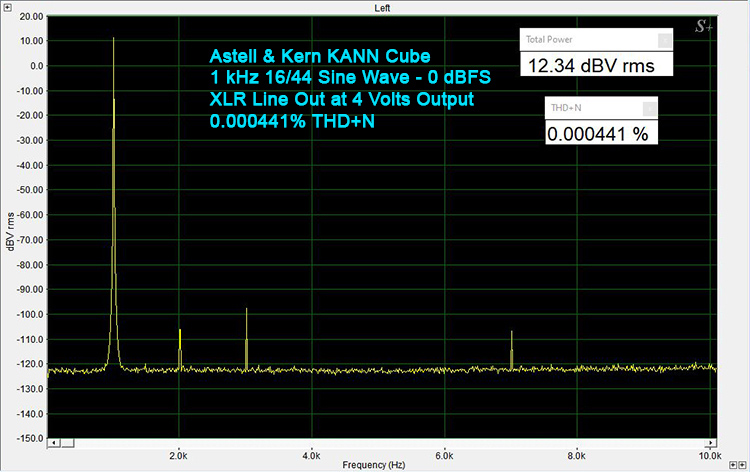
Let’s begin with the 16-bit, 44 kHz test signals. At 1 kHz through the XLR output, THD+N was 0.000441%. We see just a few harmonics throughout the spectrum with the second-order harmonic at 2 kHz being about 116 dB below 4 VRMS. The third-order harmonic at 3 kHz is 108 dB down from 4 VRMS.
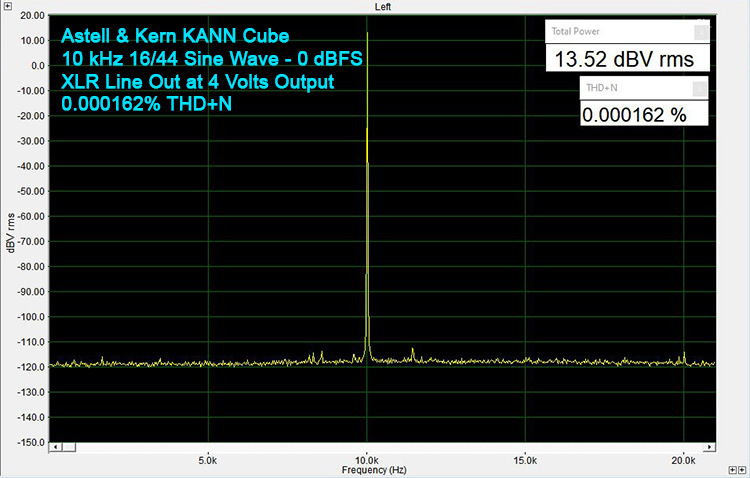
At 10 kHz through the XLR output, THD+N was 0.000162%. The second harmonic at 20 kHz is extremely minute at about 126 dB below 4VRMS.

When moving to 24-bit, 96 kHz test tones, the 1 kHz tone shows a few more harmonics through the spectrum. With the 2 kHz second-order one checking in at 118 dB below 4 VRMS. The 3 kHz third-order harmonic is at 113 dB below 4 VRMS.
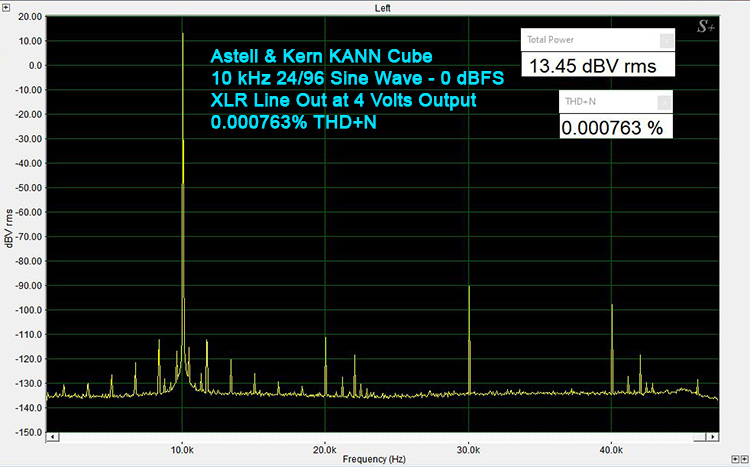
At 10 kHz, and 24-bit/96kHz sampling rate, THD+N was 0.000763% at 4 VRMS. We see some distortion spurs in the spectrum with the second harmonic at 20 kHz being about 124dB below 4 VRMS. Third-order at 30 kHz is at 103 dB below 4VRMS.

Here are the results for the 19 kHz, 20 kHz combined test frequencies using the XLR output with 24-bit/96kHz sampling at 3 VRMS. IM spurs at 18kHz and 21kHz are down 98 dB from 3 VRMS.
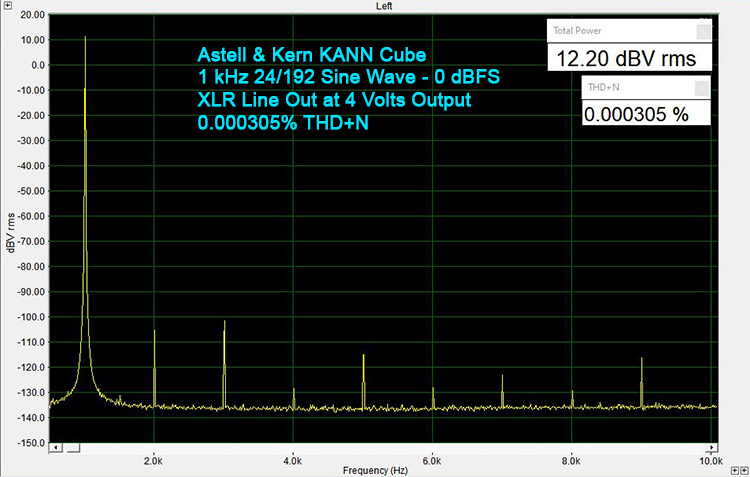
With 24-bit, 192 kHz sampling, a 1 kHz tone through the XLR output produces a THD+N of 0.000305%. We see a few harmonics throughout the spectrum with the second-order harmonic at 2 kHz being about 117 dB below 4 VRMS. The third-order harmonic at 3 kHz is 114 dB down from 4 VRMS.
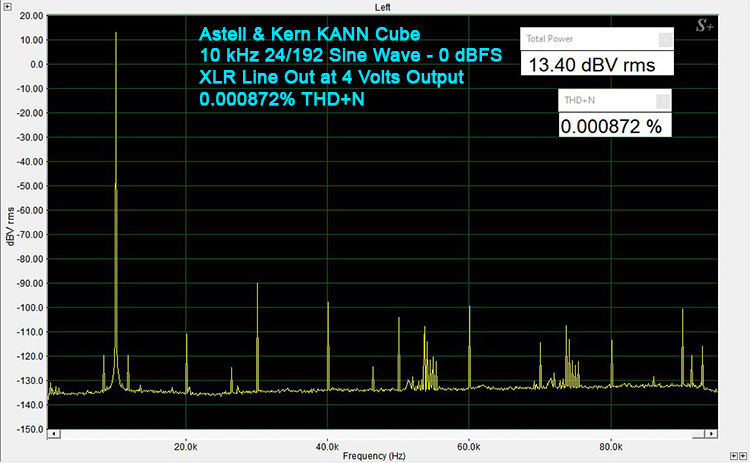
At 10 kHz, and 24-bit/192kHz sampling rate, THD+N was 0.000872% at 4 VRMS. We see some distortion spurs in the spectrum with the second harmonic at 20 kHz being about 123dB below 4 VRMS. Third-order at 30 kHz is at 103 dB below 4VRMS.

For the 19 kHz, 20 kHz combined test frequencies using the XLR output with 24-bit/192 kHz sampling at 3 VRMS, the IM spurs at 18kHz and 21kHz are down about 97 dB from 3 VRMS.
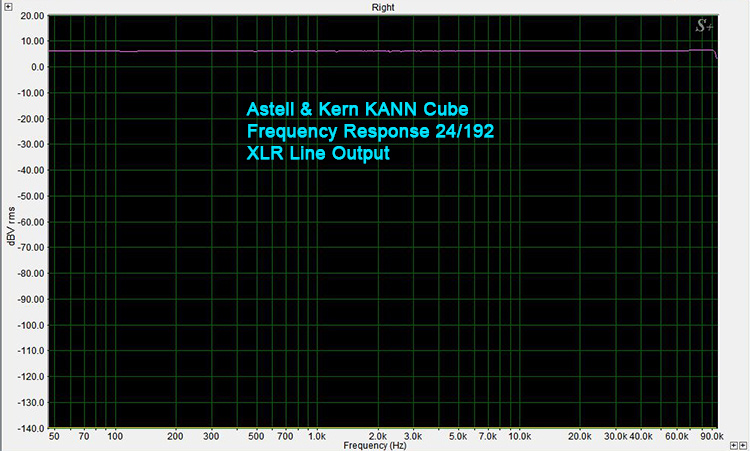
Frequency response is ruler flat. Essentially a straight line out to 90 kHz, after which there is a steep roll-off.
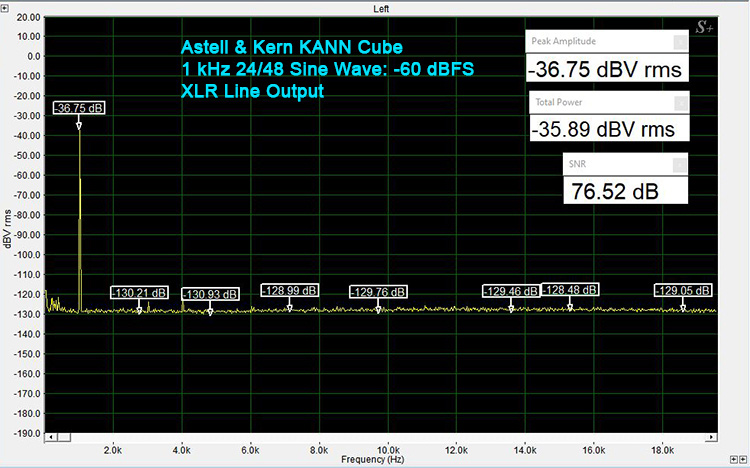
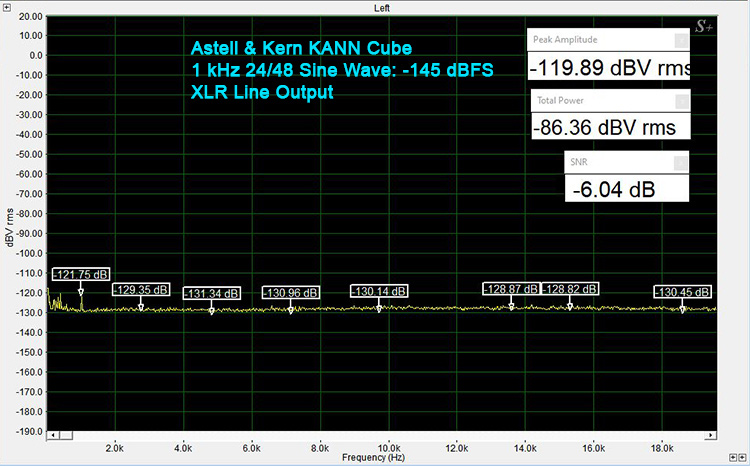

DAC Linearity plots were put together by plotting the results of 15 individual measurements of a 24-bit, 1 kHz test tone beginning at -20 dBFS and getting progressively lower in level to -150 dBFS. These test tones were loaded into the KANN CUBE’s memory and played back and measured through the XLR line outputs. Above are 3 examples from the 15 measurements. The 1 kHz tone at -60 dBFS shows the point where all distortion spurs, outside of 1 kHz, have disappeared into the noise floor. The –60dBFS spectra and below are amazing that they have no spurs at all just noise. That is partly to do with running on batteries (no hum spurs), but also it has to be very carful design to keep digital clocks from mixing down. At -145 dBFS we can see where the 1 kHz spur is still barely above the noise floor. And at -150 dBFS the 1 kHz tone has just disappeared into the noise floor.
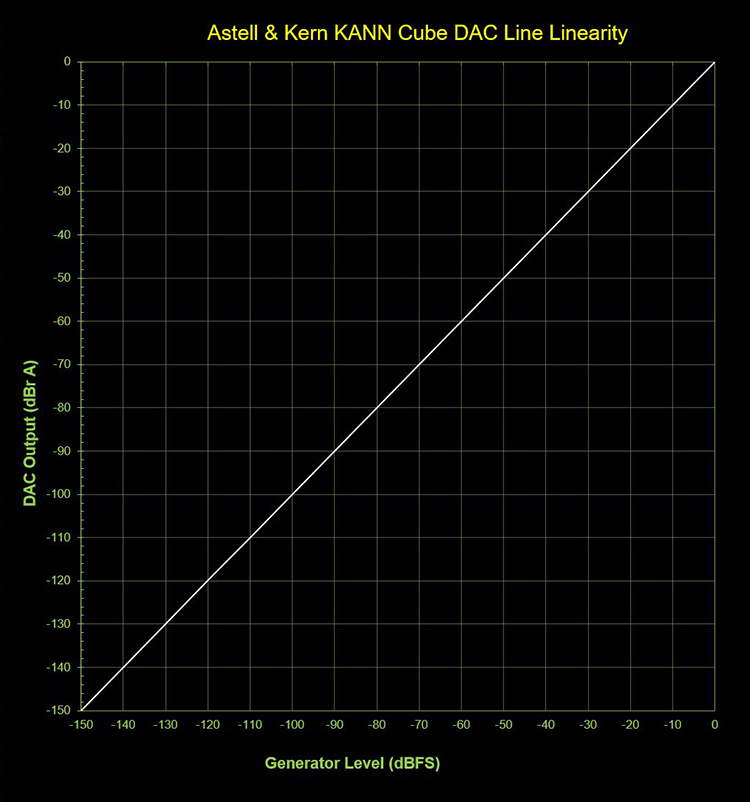
Here is the Line linearity plot of the ESS ES3098PRO DACs used on the main left and right channels based on our measurements. The KANN CUBE uses two of these eight-channel DAC chips (one for L and one for R) to cover D/A conversion. An ideal linearity measurement would show a perfectly diagonal line from 0 dB down to the system noise floor, indicating that the measured DAC output level is identical to the signal input level. As you can see, the Astell&Kern KANN CUBE measures exceptionally well.
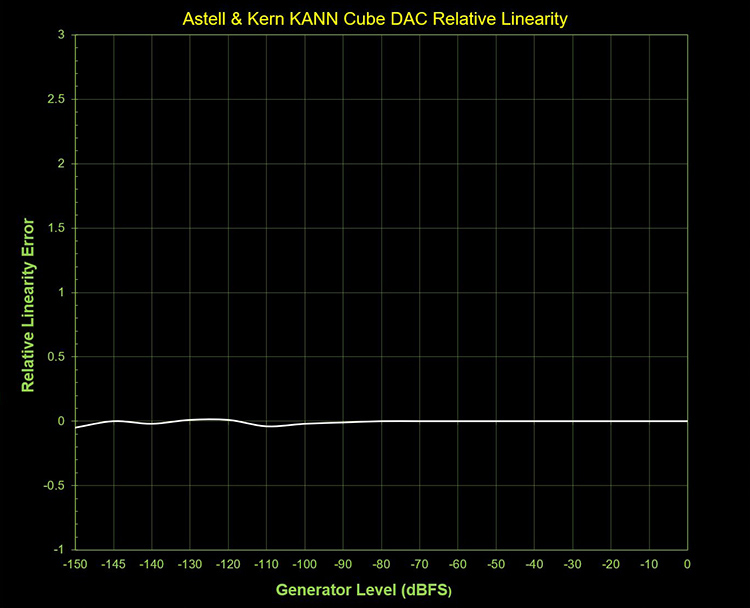
This Relative Linearity chart shows in a more exaggerated, and easy to see manner, that the Astell&Kern KANN CUBE exhibits the most minuscule levels of linearity error starting at -90 dBFS, becoming more noticeable at -110 dBFS and then improving for a bit until finally turning more significant at -150 dBFS, at which point we get into the measuring system noise floor.
Secrets Sponsor
Through all these linearity measurements we can determine the SNR of the CUBE is 122dB. The Lynx sound card has a noise floor of 123dB and the best DAC processors we have tested by Benchmark and Bryston showed about 1dB less noise. Those processors had SNR that exceeded the Lynx.
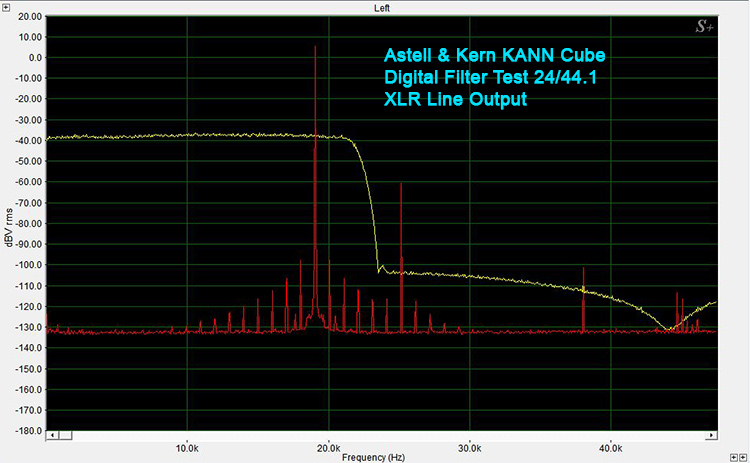
There are no user-selectable digital filter options for the Astell&Kern KANN CUBE. The above digital filter test is based on a protocol suggested by Jurgen Reis of MBL Audio. This noise test shows the characteristics of a sharp filter that is flat to 22 kHz (with a 44k sample/sec input) with a steep roll-off thereafter. The reconstruction tone of a 19KHz signal is down 65dB. This is as it should be. Some products have filters that can produce a high-end droop and minimal rejection of the 19kHz reconstruction tone.
All in all, from an objective standpoint, the Astell&Kern KANN CUBE produces impressively low THD+N numbers and has excellent linearity characteristics. One should have no qualms using it as a source component in a high-end stereo system let alone in its intended portable use.

The KANN CUBE is a device built for those who seek a no-compromise musical experience in their day-to-day listening, even if it means a bulkier device and a shorter battery life.
- Outstanding sound quality delivered consistently between various head and earphones
- State of the art DAC SNR and Linearity
- Solid build quality and appealing design
- The sleek interface provides ease of use and smooth experience
- Billie Jean earbuds provide a consistently high-quality experience across all devices
- Improved battery life
- Include a 9V charger
The Astell&Kern KANN CUBE is an impressive machine, hitting home with the design of the unit and the overall listening experience. While this monolith’s might is great, it comes at a cost of convenience in the day-to-day. But then again, those who carry the monolith don’t want the day-to-day; they want to be transported across time and space to a mysterious room where they can watch themselves slowly age and then be reborn as a child of the stars. That is to say, those who make the investment and choose to get used to the CUBE’s size and shorter battery life will be rewarded with a more enjoyable daily listen. This is something that each person will have to consider before purchasing the CUBE. Is the customer willing to part with $1500.00 for the extra power? Does the size of the device and the comparative brevity of its battery life create a drawback that can’t be ignored? When taking these things into account, the KANN CUBE is, for someone like myself, a challenging thing to justify. Granted, I am just an unemployed high school student and someone who has a healthier pocketbook than I may be inclined to take the dive. Personally, I’m currently stuck with my phone. That being said, my time using the CUBE has certainly been an interesting paradigm shift for me, if only a temporary one. It was eye-opening to listen to music reproduced on such an elevated level from something that you can carry around, and the Billie Jean earbuds certainly added to the experience. The use of upmarket earbuds definitely enhanced my listening pleasure, as your everyday dime-a-dozen earbuds can only go so far. The CUBE and the Billie Jeans may compliment pinstripe suits better than tattered denim, but they’re certainly a tempting proposition for people who truly care about the sound of their music.
By the way, did they mention if this “monolith” is supposed to show up at the foot of your bed, like in 2001 A Space Odyssey?


